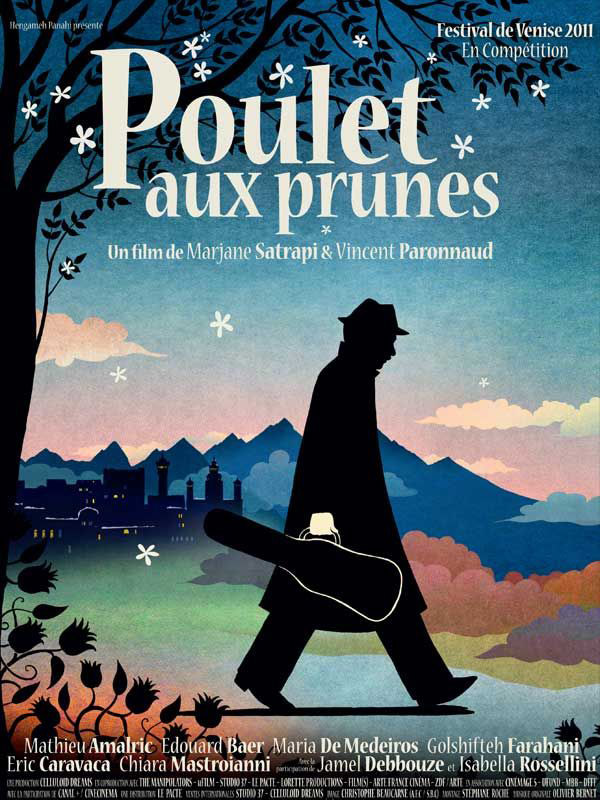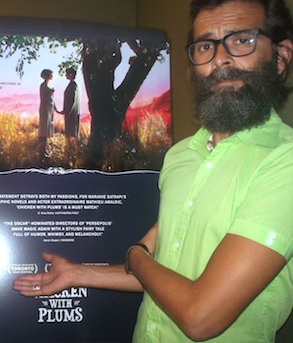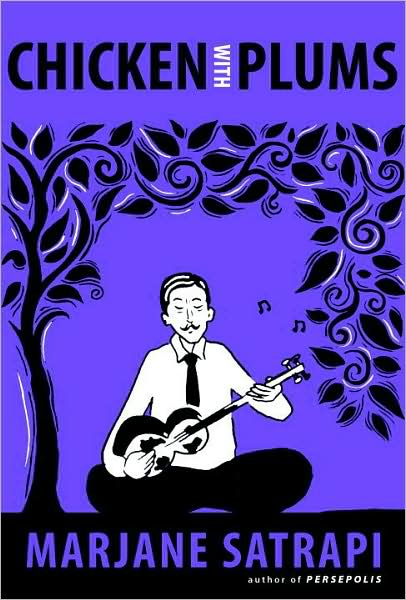Iranian-born
director and artist
Marjane
Satrapi lives in
Paris,
France, and has never lived in post-revolutionary
Persia throughout her adult life. Yet her home
country has shaped and influenced her creative work whether it be
her written and drawn graphic novels or her feature films.
In 2000, an
independent book of bande dessinťe (as comics are called in
French) was released called
Persepolis.
Written and
drawn by Satrapi, it was an eye-opening autobiographical story about
her childhood in Iran, her family's escape (and some cases death),
her move abroad and the demons faced in herself and the world around
her.
Simultaneously
tragic, funny, and enlightening,
Persepolis garnered
acclaim and Satrapi got to direct an animated adaptation in 2007
with artist and co-director
Vincent
Paronnaud.
Because she
gained attention for its unique style and story Ė it won awards at
festivals (including Cannes 2007) and was nominated for an animation
Oscar, Satrapi has gone on to write more
graphic novels, including
Chicken With Plums, a tragic tale based on the
life and death of a relative of Satrapi's.
Now the
graphic novel has been transformed into a live action adaptation
starring
Mathieu
Amalric,
Maria de
Medeiros and
Golshifteh
Farahani with Satrapi and Paronnaud in the director
chairs again.
The following
Q&A is drawn from a small roundtable with Satrapi and Paronnaud held
at the
Gramercy
Park Hotel just before the release of the film in
NYC.
With this shift in technologies, how have you grown since the
previous film?
Marjane Satrapi:
Growing up is realizing that the more experiences you achieve, the
more you understand that you donít know so much. This wheel of being
Ė trying to make things before I die Ė itís not like I have 3000
years ahead of me and I can just go on, it's a very simple
calculation. Iíve calculated that I have about 30 years to live and
work, so each project takes me three years, so ten percent of my
time.
So 10 projects
and Iím gone. In the 10th project I have to make the maximum of what
I feel like doing.
I am more
aware of my death, like everybody I guess. But I feel happy. Itís
very sad that we have to die, of course, but there isnít anything we
can do. Itís better to laugh.
 What
is it like dealing with an actor compared to telling a story with
illustrations?
What
is it like dealing with an actor compared to telling a story with
illustrations?
Marjane Satrapi:
Well there are different moments you film, but
Mathieu Amalric is a very talented and gifted actor
who expresses lots of things even when heís not doing anything, like
in
The Diving
Bell and the Butterfly. Heís very expressive and
he has this thing in his eyes, this fever. Heís a very gentle person
who is really at the service of the film. It was good for him to be
on the set, it was like a playground.
Heís somebody
whoís actually not scared of playing different roles. He doesnít say
ďIíll look ridiculous, I wonít do that.Ē When an actor believes in a
film, and is committed, and is a great actor like we had the chance
to have, then itís not such a difficult thing to do.
The difference
with animation is that in animation you decide what you want, you
make the movements in front of the animators and they copy you. You
are in control of the project. But when you have actors, they take
the story, and when theyíre great, they take it much further than
what you imagined.
For instance,
when you see
Maria de
Medeiros, who plays his wife,
Faringuisse,
for us she had a range of sentiment and played a nasty woman, but
then we feel compassion for her. She became a bitch at the
beginning, but she becomes beautiful, you love her and you want to
protect her. You want to shake him and say ďLook at this beautiful,
incredible wife! Why donít you want to love her?Ē
Sometimes as a
director, you donít direct and you just become the viewer of your
own film if it goes this way.
Mathieuís eyes are amazing in this film.
Marjane Satrapi:
The eyes are his eyes, but nobody was as close to the book as
Mathieu himself. Every morning I would visit him when he was doing
the makeup and he would say ďMarjane, but the book!Ē And I would
say, ďYes, Mathieu, I know, I wrote the book myself. Forget about
it, itís a work of adaptation, concentrate on your character!Ē
He doesnít
need anyone to make eyes like that, heís an extremely talented actor
and good person.
Is it a challenge going from drawing a graphic novel to
storyboarding a film?
Marjane Satrapi:
We must not forget that the book is a book, and it happens that the
book is my book, but even if it was someone elseís book, weíd do it
the same way. Meaning, it would be an adaptation.
The
storyboards and the comics are not the same; the language is not the
same. With Persepolis we forgot about the book very quickly.
Was there a sense of myth present in the drawing process?
Marjane Satrapi:
Of course, but the only movie maker that knew how to drawÖI think
Fellini drew well. Itís visual art, so itís a plus
if you know how to draw a very simple thing. Like if you want to
show something to your set designer, instead of using 2000 words,
you make one sketch and he understands what youíre talking about.
Itís a plus.
Or maybe since
youíre more visual, you can imagine how everything will look. But
there are plenty of good movie makers that donít know how to draw.
For us, because when we had to re-create a whole world, it was
probably a plus.
But it had an
effect on how we do things, I donít know. Maybe on this movie it
helped because the framing was very classic [in style]. In other
genres of cinema I donít think, because you have to know the
techniques of cinema.
Music also plays a mythic role in this film. What made you feel a
passion for music?
Marjane Satrapi:
Well you have to have some kind of passion, and why not music? You
break your instrument and your heart can be broken, or because your
heart is broken your music is not good. If you paint and you break
your brush, you break your brush every week. You donít break a
Stradivarius every week, you just go out and buy a new brush and
itís no big deal.
Of course the
music plays a big role, and we were lucky to work with a great
musician thatís an old friend of
Vincentís
[Paronnaud,
co-director],
Olivier
Bernet. They had a rock band for a long time and
this boy is extremely talented. They work together and I was
listening, the things you like or donít like.
Since we
prepared the movie, we had an animatic before we finished the film
so Olivier started composing the music to the animatic. So the music
was not completely finished because you finish it on the real
images. But we had the maquetes, so we played the music on the stage
to put the actors in the mood.
 What
kind of music did your band play?
What
kind of music did your band play?
Vincent Paronnaud:
We come from the south of
France.
Very underground.
Did you use different musical influences from the North?
Marjane Satrapi:
Pure rock. But they also used in the music some violin and stuff you
donít normally use in rock music.
Smoking has never been so passionately depicted. Are you both
smokers?
Marjane Satrapi:
Yes.
There's a different perception of smoking here in the States.
Marjane Satrapi:
Itís the fashion now to hate smoking. Like all the problems in the
world are solved, no pollution, no shit in water, so now the only
problems people have are smoke and smokers. Itís like if you donít
smoke, then youíre not going to die.
The particles
that stay in your lungs, carbon monoxide, that comes from cars.
Before forbidding smoking we should forbid cars, and then weíll
talk. But both of us are smokers and are proud of it. I donít want
to quit smoking; Iíve been one all my life.
Could you
imagine
Humphrey
Bogart without his cigarette or
Lauren
Bacall without hers? I could go on all day.
Rita
Hayworth without her cigarette?
Jennifer
Aniston and
Zac EfronÖ
Bacall and Aniston, there is no comparison [between them]. Sexually,
from an attraction point of view, everything is not on the same
level.
Smoke is
extremely cinematic. Itís extremely nice to film. Itís also a symbol
of life. One second itís there, the next itís not. It disappears, it
gives you some pleasure, itís a beautiful thing.
But today, if
someone smokes, especially here in the film they have to turn down
the light on the cigarette and in the next few minutes heíll kill a
woman, or a child, or blow up a building. The bad guy is coming, he
lighting up his cigarette.
I had two
grandmothers, both of them smokers, they lived a long time and I had
two uncles that were health freaks and they both died in their early
60ís from cancer.
Even in the
'80s
everyone was smoking.
Bruce Willis
could smoke. Today, everyone is like *gasp*! I donít quite
understand.
I think
smokers are very sexy the smoke as an object is very beautiful to
film and photogenic. It gives you some style. And if you donít have
any style...
 The
film is very stylized Ė like the comic. How did you conceptualize
it?
The
film is very stylized Ė like the comic. How did you conceptualize
it?
Marjane Satrapi:
In the film you have many layers. You have one underneath layer with
the story in the
1950ís
with the coup díťtat that happened in
Iran
and the end of democracy, and the name of the lover is
Irane,
which is equivalent to naming a character
America
in an
American
film. Then you have a very realistic story about the people that are
there with no hocus pocus fable things.
Everyone has
their good moments, their bad moments, you donít have a hero, you
have a guy that doesnít like his children at the beginning but then
he does at the end. Everybody, each character has ambivalence, like
it is in life. You donít have great or bad people.
Then you have
another layer of realism, which is the way you remember your
memories. Obviously when you remember, not only does it come in
pieces, not chronological, some pieces are very detailed and
colorful, and some are just an action, plus, this whole reality is
how you remember them, not the reality. Now in all this remembrance,
how to make out of this boring story about a man who wants to die,
an attractive story?
You have all
this work of memory, plus the cinema is a domain where there is no
limit to your imagination, plus the fact that none of us come from
film school, we just go freestyle. All of these were things we loved
and wanted to show in a certain way and it was the result of lots of
work.
The big
challenge was to be able to make it in the way that it would not
look patchwork, the film should be an entity in and of itself.
We had a great
set designer, we watched movies, did documentation, photos, but itís
a synthesis of all of that. The research you do at the beginning,
the result is not always exactly related to that.
What was in casting Golshifteh Farahani who played Irane?
Marjane Satrapi:
Sheís well known in Iran, but she cannot live there anymore, she
lives in France. The reason she was taken isnít because her name was
Irane, it was that when youíre young and you fall in love, you donít
fall in love wondering if sheís intellectual and if youíre going to
have good discussions. When youíre young and fall in love you look
at someone and *gasp* youíre in love. This is the love of youth.
We needed a
girl that when you see her, youíd be like ďwow.Ē And it was this
one. She has something of wild beauty that is difficult to describe,
but she has this innocence in her face and you see her and
everyoneís in awe of her.
We needed
somebody with this face that you donít know where it comes from. She
has made nearly 25 films when she was in Iran, but she played in one
American film with
Leonardo
DiCaprioÖ
Is that why she was banned?
Marjane Satrapi:
She played in that film,
Body
of Lies, and they asked her, ďwhy do you play in
an American movie?Ē She could not work there anymore, and that was
it. If you make a problem, then you go.
Iím not making
Iranian cinema or am part of the Iranian cinematic movement because,
simply, I do not work in Iran. I left Iran when I was very young, I
studied outside. All of my career, my life was outside Iran. Iím
Iranian but Iím French.
If someone
makes a film about
Spartacus
like
Ridley Scott,
it does not make him a
Roman.
This is a French film. If you want to talk about the film makers in
Iran, I donít know any of them personally.
You might be helping themÖ
Marjane Satrapi:
I donít think I can help anything. The government of my country does
not like me. If I say to the government ďplease free these people,"
they will say, ďyou are a woman who is a hooker in our eyes, why
would we listen to you?Ē I am considered an enemy
Any approach I
make to an Iranian film maker will only make their situation worse.
This is why I choose to be far away from them.
What
is the symbolism of the chicken with plums?
Marjane Satrapi:
But
I can tell you exactly. It is a food that comes from the region I
was born in, near the
Caspian Sea.
When men in my family went to eat the plums, they would say they
were eating
Sophia Loren
because they were round and juicy and sweat. Everyone called the
plums the Sophia Loren.
The title is
very important because a film that is a melodrama. If you call it
The Life of Nasser-Ali Khan,
The Musician it becomes too obvious. Itís more fun. But
itís more than that. Thereís a moment in this film, the only
relationship he has with the real world, which is his wife, is
through the food.
Then thereís a
moment in the film when he has a dilemma, he can sit down and eat
and not die, but he decides not to eat. But this is a man that loses
his pleasures one by one. And what is the last pleasure we can lose?
Eating.
You can live
without making love. Youíre miserable, but you survive. But without
eating itís impossible to survive. Also, this is a moment where you
dive into his past. Itís an important moment that looks like
nothing, but itís the turning point.
Do you make chicken with plums?
Marjane Satrapi:
Yes, but I swear to god, I donít lie, I love that food but I didnít
use to make it very often. But after making this film, everybody
says ďmake me chicken with plums so we can see if itís really
tasty.Ē So I have to make chicken with plums for everyone.
You have mentioned your love for the late great Japanese director
Akira Kurosawa and
Rashomon Ė
his seminal film of a crime described by several from very different
perspectives. This film uses a similar narrative strategy. Were you
influenced by other filmmakers?
Marjane Satrapi:
A point of view is only interesting if we all have different point
of views, otherwise we have to make
Superman
and heís very nice and itís not the same kind of movie. To come
back to
Kurosawa,
Iím obsessive. With Kurosawaís
Seven
Samurai, that is the film I have seen the most
in my life. 360 times, at least.
At the age of
10, I became obsessed with this film, and every day I came back from
school I watched it. Every day, without exaggeration. Kurosawa is a
master. I donít need to tell you that.
You wonít do a remake.
Marjane Satrapi:
There are things you canít remake. You canít remake
Citizen Kane,
you donít remake
8Ĺ
or other
Fellini,
itís not possible. Theyíre already very nice.
Do you like other comics Ė ones that influence you?
Marjane Satrapi:
I love American cartoonists. Vincent is much better than me at
talking about comics. What is your favorite?
Vincent Paronnaud:
My comics. Well,
and [Robert]
Crumb.
Marjane Satrapi:[I
love]
Charles
Burns. My next project will probably be, if
everything goes well, an American film.
To be shot here?
Marjane Satrapi:
Iím not going to shoot it here, but the script is American. itís not
my script. Itís a story of a psychopath,
The
Voices. We have to see if people are going to do
it.
It must be fun working for someone else for the first time.
Marjane Satrapi:
Yes, but I told you, I only have 10 projects. I have to try whatever
I can try in this short time.
Email
us Let us know what you
think.